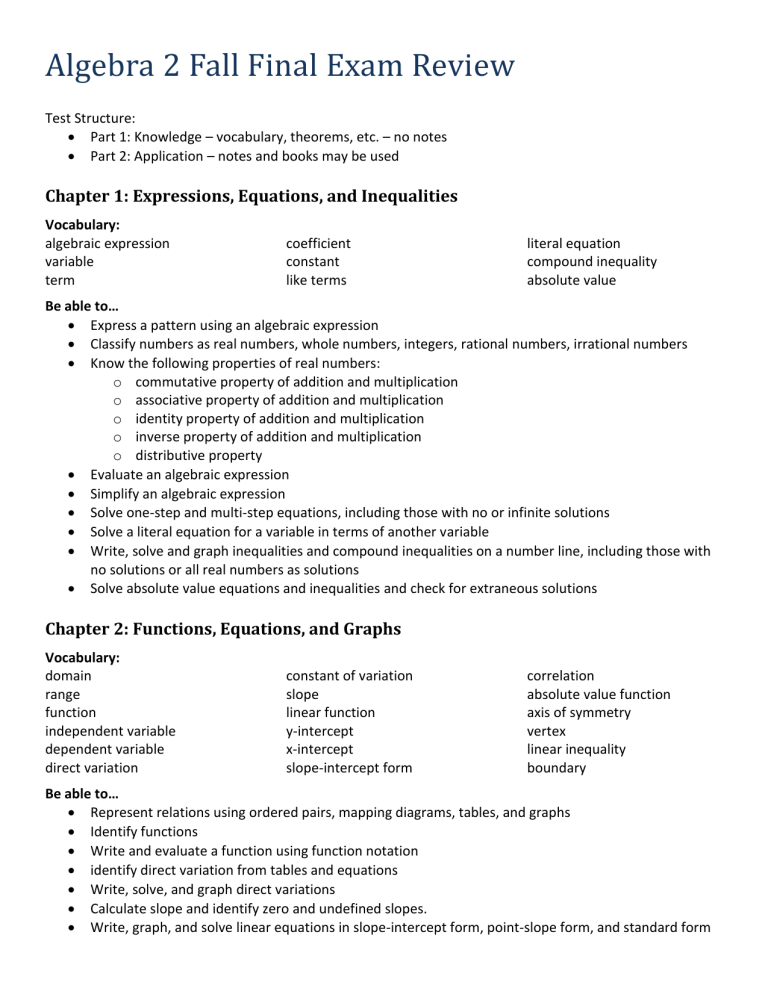Fall Final Study Guide

Algebra 2 Fall Final Exam Review
Test Structure:
Part 1: Knowledge – vocabulary, theorems, etc. – no notes
Part 2: Application – notes and books may be used
Chapter 1: Expressions, Equations, and Inequalities
Vocabulary: algebraic expression variable term coefficient constant like terms literal equation compound inequality absolute value
Be able to…
Express a pattern using an algebraic expression
Classify numbers as real numbers, whole numbers, integers, rational numbers, irrational numbers
Know the following properties of real numbers: o commutative property of addition and multiplication o associative property of addition and multiplication o identity property of addition and multiplication o inverse property of addition and multiplication o distributive property
Evaluate an algebraic expression
Simplify an algebraic expression
Solve one-step and multi-step equations, including those with no or infinite solutions
Solve a literal equation for a variable in terms of another variable
Write, solve and graph inequalities and compound inequalities on a number line, including those with no solutions or all real numbers as solutions
Solve absolute value equations and inequalities and check for extraneous solutions
Chapter 2: Functions, Equations, and Graphs
Vocabulary: domain range function independent variable dependent variable direct variation constant of variation slope linear function y-intercept x-intercept slope-intercept form correlation absolute value function axis of symmetry vertex linear inequality boundary
Be able to…
Represent relations using ordered pairs, mapping diagrams, tables, and graphs
Identify functions
Write and evaluate a function using function notation
identify direct variation from tables and equations
Write, solve, and graph direct variations
Calculate slope and identify zero and undefined slopes.
Write, graph, and solve linear equations in slope-intercept form, point-slope form, and standard form
Identify and write equations for parallel and perpendicular lines using slope
Create a scatter plot, use linear regression to determine a line of best fit, and use that line to make predictions
Apply transformations (translations, reflections, stretches and/or compressions) to functions and write the equation of the transformed function
Graph absolute value functions as transformations of the parent function f(x) = |x|
Graph linear inequalities and absolute value inequalities
Chapter 3: Linear Systems
Vocabulary: system of equations inconsistent system consistent system independent system dependent system constraint feasible region objective function
Be able to…
Write and graph systems of linear equations and linear inequalities
Classify systems of linear equations by the number of solutions
Solve systems of linear equations using substitution, elimination, and equivalent systems
Solve systems of linear inequalities by graphing
Use linear programming to find a minimum or maximum value given a set of constraints
Solve systems in three variables using substitution, elimination, and equivalent systems
Solve systems of equations using a matrix
Chapter 4: Quadratic Functions and Equations
Vocabulary: parabola vertex form axis of symmetry minimum/maximum value standard form perfect square trinomial difference of two squares
Zero-Product Property
Quadratic Formula discriminant imaginary unit (i)
Be able to…
Graph quadratic functions as transformations of the parent function f(x) = x 2
Given a quadratic function in vertex form, identify the vertex, axis of symmetry, maximum or minimum value, domain, and range
Write a quadratic equation in vertex form
Given a quadratic equation in standard form, identify the vertex using a calculator or algebraically
Graph quadratic functions in standard form
Convert standard form to vertex form or the opposite
Write an equation for a parabola algebraically or using quadratic regression
Find common and binomial factors of quadratic equations, identifying special quadratic expressions when appropriate
Solve quadratic equations by graphing or by factoring
Rewrite and solve quadratic equations by completing the square
Solve quadratic equations, including complex number solutions, using the Quadratic Formula
Use the discriminant to determine the number of solutions for a quadratic equation
Simplify numbers using i and perform operations on complex numbers
Solve and graph systems of linear and quadratic equations and systems of quadratic inequalities
Chapter 5: Polynomials and Polynomial Functions
Vocabulary: monomial degree of a monomial polynomial degree of a polynomial standard form of a polynomial turning point end behavior factor theorem multiplicity relative maximum/minimum sum or difference of cubes
Be able to…
Classify polynomials according to degree and number of terms
Graph polynomial functions and describe end behavior and number of turning points
Write a polynomial in factored form
Find the roots (both real number and complex number) of a polynomial function
Write a polynomial function from its zeros
Solve polynomial equations by factoring or graphing








